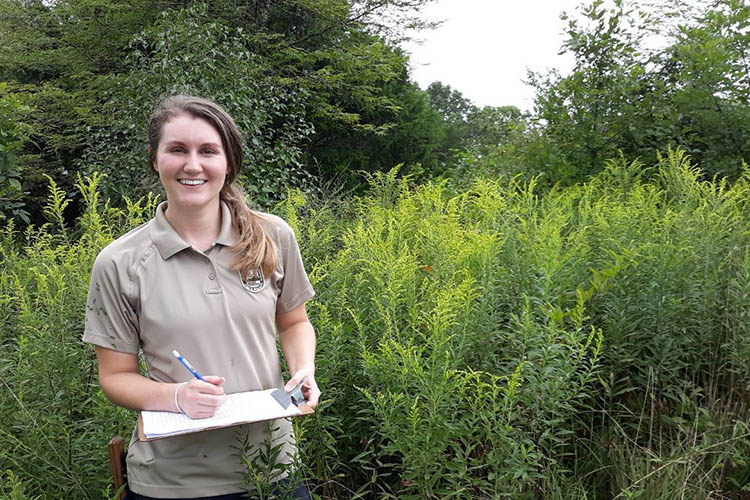Celebrate wildlife 365 days a year
Celebrate wildlife 365 days a year

LEXINGTON, Ky., — The beginning of September brings wildlife awareness with the 64th anniversary of Congress’s passage of the Wilderness Act, the purpose of which was to preserve and protect certain lands and secure the benefits of wilderness for future generations. Following on its heels is National Wildlife Day, a holiday to promote endangered species conservation and wildlife diversity across the country.
Many environmental enthusiasts, however, celebrate wildlife year-round. Whether it’s preserving and encouraging backyard songbirds or squirrels, fish in Kentucky’s many waterways, or larger species that inhabit woodlands, wildlife conservation affects every Kentuckian. No one knows this better than Michaela Rogers, a University of Kentucky Natural Resources and Environmental Science alumna and environmental scientist with the Kentucky Department of Fish and Wildlife.
“Wildlife is a key part of our natural resources in Kentucky,” she said. “Whether someone enjoys hiking or bird watching, fishing, hunting or simply being outdoors, outdoor recreation would be lacking without wildlife. Conservation is critical to keeping our overall environment healthy for both humans and wildlife.”
Habitat loss and degradation is behind the loss or decline of many species. Invasive species introduced from other parts of the world are threats, whether by crowding out native plants that provide food for wildlife or infesting and killing native flora. The introduction of the invasive insect, hemlock woolly adelgid, for example, has resulted in the death of 80% of hemlock trees in some parts of the Appalachian region. More than 120 animal species depend on eastern hemlock forests for habitat. The loss of those trees could have resounding effects on the ecosystem.
“Disease can also have devastating impacts, such as we are currently seeing in species like bats, many of which are heavily impacted by white nose syndrome,” Rogers said.
Wildlife should be protected because they play a pivotal role in the state and the world, said Matt Springer, assistant extension professor of wildlife management in the UK College of Agriculture, Food and Environment.
“They provide ecosystems services like insect pest control and scavenging, recreational opportunities through hunting, fishing, photography, birding and herping (searching for amphibians or reptiles) to name a few, and nutritious meals to our residents and those less fortunate through Hunters for the Hungry,” he said. “Plus, the associated activities annually contribute approximately $1 billion dollars to our state’s economy. Maintaining the species we have and conserving their habitat will help keep these important benefits around for generations to come.”
All wildlife need three basic things: shelter, food and water. The key to attracting and retaining a variety of animals and insects is to develop diverse habitats through plantings and water sources. Even simple steps can encourage a robust animal presence in woodlands or on farms. Undisturbed riparian zones along stream banks, ponds and lakes prevent sediment from flowing into the water and harming aquatic life. In the urban landscape, using native plants, providing water, and reducing both lawn area and chemical usage will attract a greater variety of birds, small animals and pollinators.
Rogers encourages students who are interested in the environment to take advantage of as many opportunities as possible
“Gain hands-on experience in the field, whether it be helping with graduate student research projects, or interning during the summer with a consulting company or environmental/wildlife agency. Working on projects with experienced biologists will help you gain invaluable skills and allow you to learn what your interests are,” she said. “‘Wildlife’ is an extremely broad field, and there is always something to be learned from those with specialized knowledge about a particular species group.
For those interested in learning more about what the Kentucky Department of Fish and Wildlife is doing to preserve wildlife diversity, and how to partner with the agency to protect wildlife, they can connect with the department’s Kentucky Wild program at https://app.fw.ky.gov/kywild/.
More information about UK’s natural resources and environmental sciences degree program can be found online, https://www.uky.edu/academics/bachelors/natural-resources-environmental-science.
For teenagers and college-aged students interested in learning more about wildlife and the environment, the UK College of Agriculture, Food and Environment offers several options. The 4-H Natural Resources and Environmental Sciences Academy is a three-year program designed to teach middle-school aged youth about their natural environment. In the program, scholars participate in hands-on investigations to learn about Kentucky’s water, forest, entomology, and wildlife resources. More information can be found at https://4-h.ca.uky.edu/NRESci.
The Kentucky Forest Leadership Program is a weeklong, residential program designed for high school students completing their sophomore and junior years. The program offers three educational tracks: forestry, entomology and wildlife. More information on can be found at https://kflp.ca.uky.edu/.
To read the full Q&A with Rogers, go to https://students.ca.uky.edu/wildlifeday_2020.
Environment Forestry

